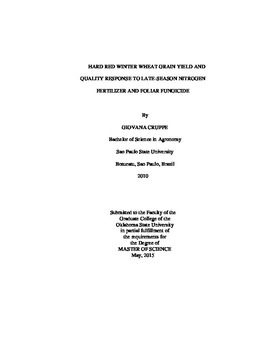| dc.description.abstract | Foliar fungicides can protect winter wheat (Triticum aestivum L.) grain yield, and farmers sometimes include nitrogen solution with fungicide applications in the hopes that added nitrogen will increase wheat grain protein, yield, or both. The objective of this study was to determine the effect of various nitrogen fertilizer-by-foliar fungicide combinations on wheat normalized difference vegetative index (NDVI), grain yield, test weight, and grain protein. The trial was conducted over six site-years during the 2012-13 and 2013-14 wheat production seasons under dryland and irrigated conditions in central Oklahoma. Experimental design was a factorial arrangement of a randomized complete block design with four replications. Factors were fungicide treatment (no fungicide or 0.77 L ha-1 Quilt Xcel), nitrogen source (urea ammonium nitrate (UAN) solution or CoRon), and foliar nitrogen rate (0, 2.8, 5.6, or 28 kg ha-1). All products were applied as tank-mixes at approximately Feekes GS 10.5.1 (anthesis). Applying 28 kg N ha-1 significantly decreased NDVI due to leaf burn, regardless of source. Grain yield was not increased by treatments except at the irrigated site, where fungicide increased grain yield by 290 kg ha-1 as compared to nontreated plots. Foliar fungicide application increased test weight by as much as 1.42 kg hl-1 in three out of six site-years. Other than the 28 kg ha-1 N treatment, grain protein was not affected by N application. Applying 28 kg ha-1 increased grain protein by approximately 1% and there was no difference between N sources. Results indicate that foliar fungicides could be beneficial in protecting wheat grain yield and test weight, but yield response will be dependent upon variety and environmental conditions. These results also show that foliar N rates necessary to impact grain protein in an otherwise well-fertilized crop also have significant potential for leaf burn, which could negatively impact wheat grain yield in some years. | |
